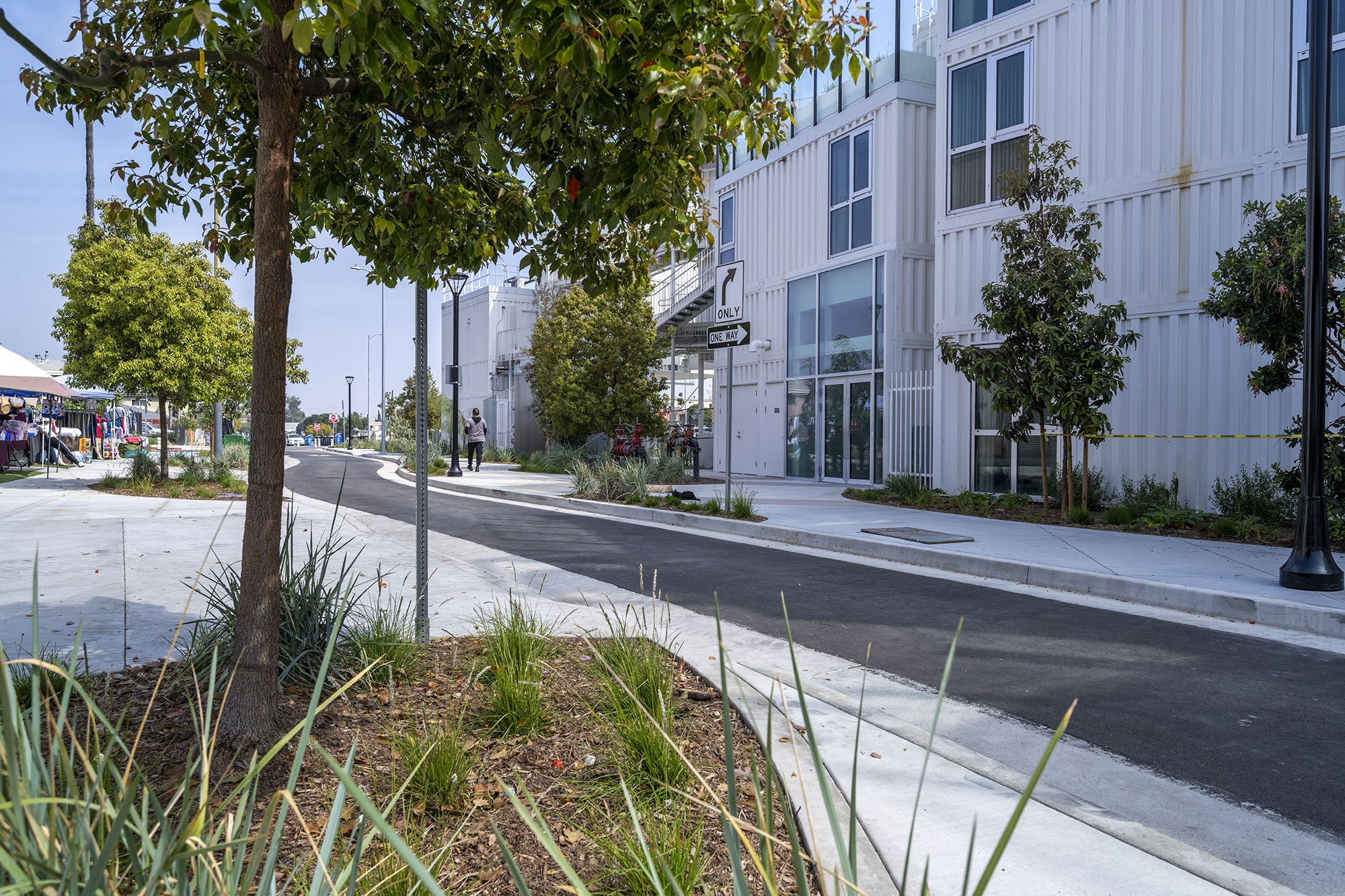
Awesome Building of the Month:
June 2024
Isla Intersections
Urban Oasis!
By Frances Anderton and David Kersh for FORT: LA
Address: 283 W Imperial Hwy, Los Angeles, CA 90061
Developer: Holos Communities and American Family Housing
Architect: Lorcan O’Herlihy Architects (LOHA)
Landscape Architect: Agency Artifact
Contractor: Geis Construction; Construction Management: Primus Building Solutions; Modular Containers: Giant Containers
Property Manager: Levine Property Management
Completed: 2024
Type of housing/Project mix: 100% affordable permanent supportive housing; 53 single-bedrooms for individuals earning 30% AMI and 40% AMI (24 for chronically homeless; 10 for formerly unhoused veterans); 1 manager unit.
Funders: CIT Bank, N.A.: Federal Home Loan Bank of San Francisco’s Affordable Housing Program (FHLB-SF AHP); Enterprise Community Partners: CA Tax Credit Allocation Committee (TCAC); Housing Authority of the City of Los Angeles (HACLA): Veterans Affairs Supportive Housing Program (HUD-VASH), Section 8 Project Based Vouchers (PBV); Key Bank, N.A.: California Debt Limit Allocation Committee (CDLAC); Los Angeles Housing Department (LAHD): Los Angeles Proposition HHH; Home Depot; Annenberg Foundation (for the Paseo); City of LA 99-year lease for $1/year.
What is Isla Intersections?
Isla Intersections is a development of 53 one-bedroom permanent supportive dwellings in a structure made of shipping containers, arranged around a shady courtyard and alongside a newly created, landscaped Annenberg Paseo with a winding road, wide sidewalks and a row of shops. The project sits at the intersection of Broadway and Imperial Highway, beside the monumental interchange of the 110 and 105 freeways. It models a highly creative use of “surplus” or publicly owned, and often difficult sites, made available recently by the City of Los Angeles to developers of affordable housing. This Paseo is a piece of the larger Broadway Sur, a street improvement project for a long stretch of Broadway at Manchester in South Los Angeles. ”
In an ideal world, no one should have to live by a noisy, polluting freeway intersection but in the real world of Los Angeles, where so much residential land is off-limits to new residences, people do. The development and design team, with support of angel donor Wallis Annenberg, City Council District 8 and numerous other backers, put smarts, soul and dollars into making it striking architecture and a livable place that could set a precedent for the future, through its use of modular shipping containers and the creation of the green paseo in an area deeply deprived of trees and walkable streets.
Cristian Ahumada, Executive Director and CEO of Holos Communities, describes the concept as a “living lung.” In today’s world, destroyed by car-based sprawl and climate change, he has said, “we’re no longer builders of buildings. We are builders of ecosystems.” For the architect Lorcan O’Herlihy, “It is in this kind of liminal space, fraught with ambiguity, that we see opportunity, and a potentially significant next step for the future of housing in the City.”
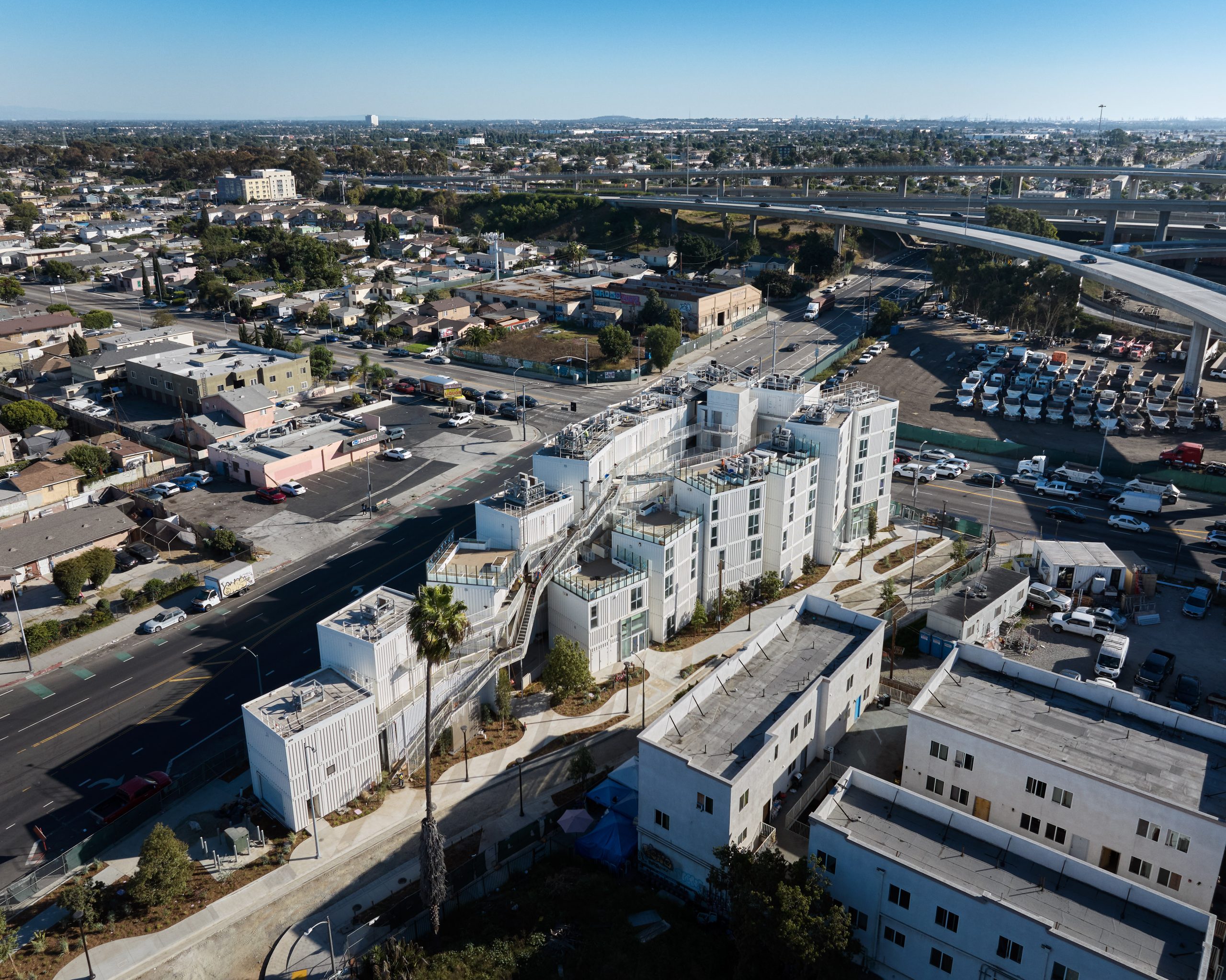
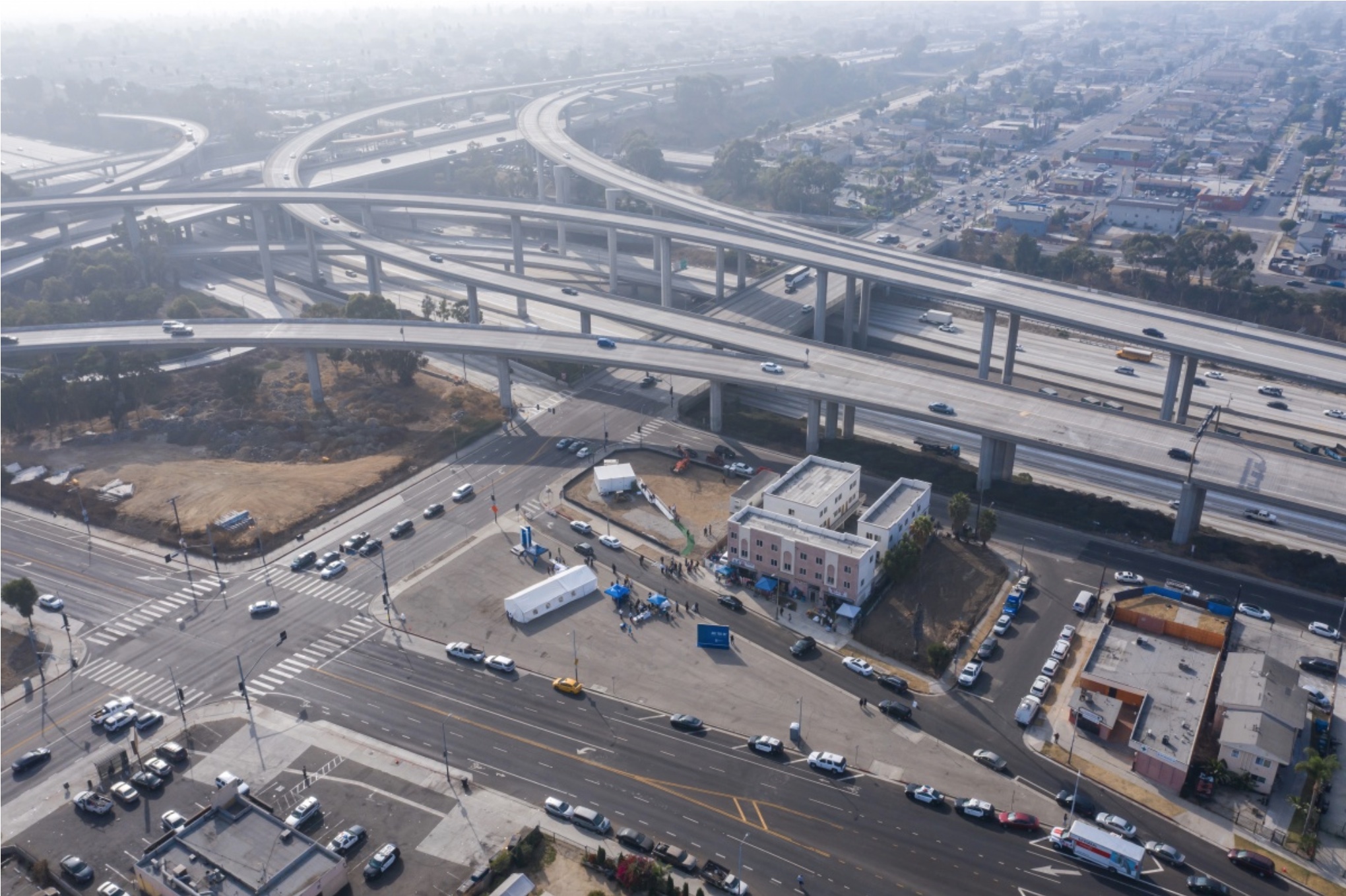
What Makes it Awesome?
Staggered stacks of white shipping containers are not everyone’s intuitive idea of home. But in the hands of this design team, they were turned into comfortable, well-lit dwellings, in an arresting structure softened with greenery on multiple levels, and dappled with light filtered through the perforated metal of outdoor walkways and staircases.
The containers are angled to dampen traffic noise, which gives the courtyard an interesting, jagged teardrop shape. There you find loungers reminiscent of a boutique hotel, and a temperature drop of several degrees from the hot and dusty streets outside. The courtyard is gently lit and ventilated by air and slivers of sunlight that filter through the spaces between the stacks of containers.
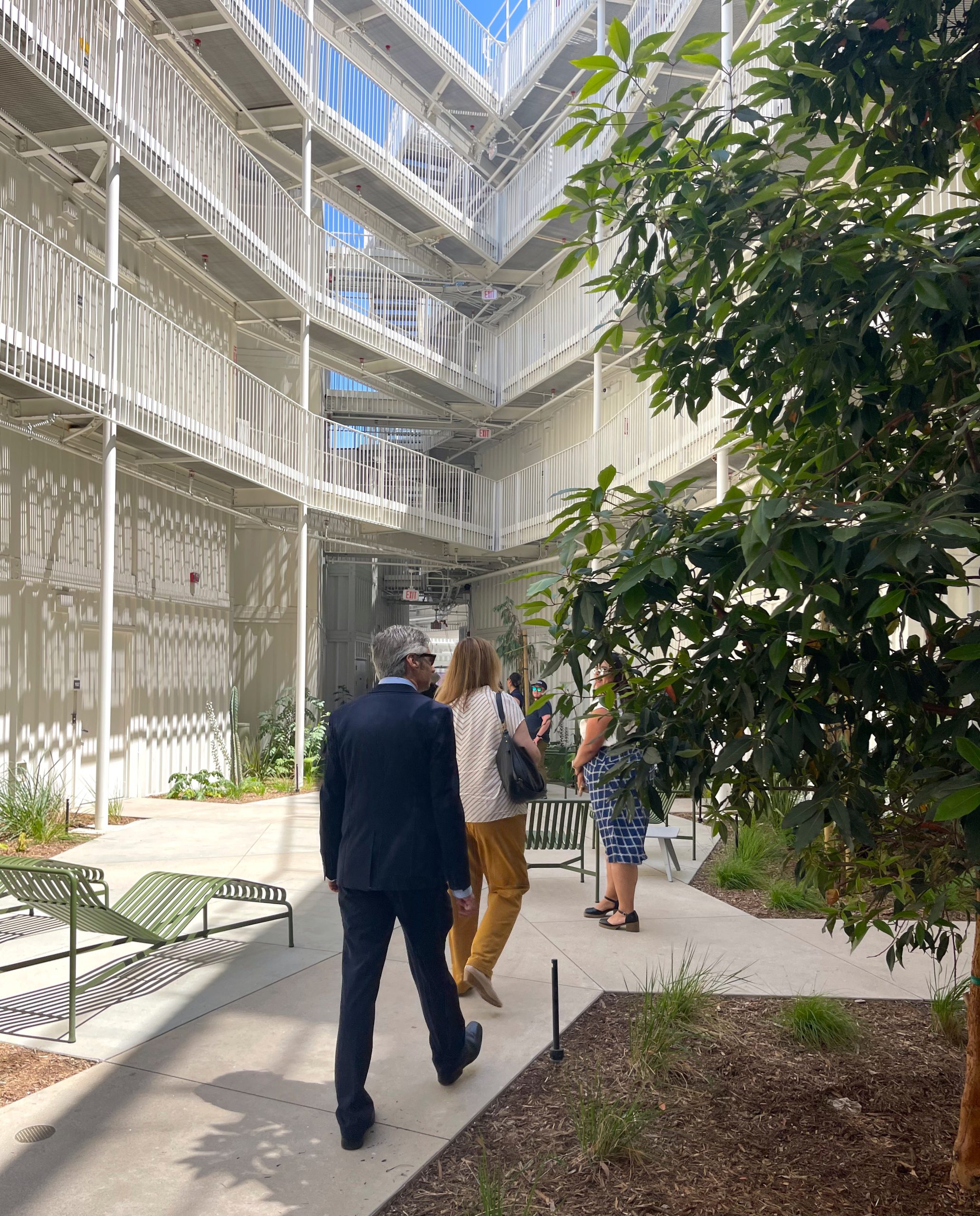
Scaling the building is an adventure, as the outdoor staircases and decks offer changing, and quite dramatic, views. The terraced decks, with glass balustrades for sound minimization, are for hanging out or gardening in the community planters run by Growing Hope Gardens. Their team will work with residents on growing and preparing vegetables.
Tenants have access to onsite supportive services such as job training, mental health services, and life skills. In addition, the ground floor contains two commercial spaces; they are aimed, says Ahumada, at BIPOC-owned businesses, “because if we’re able to help a local business thrive, particularly a business of color, that means that we’re going to help them stay safely housed.” At the ribbon-cutting in mid-June, he told visitors that in totality, Isla Intersections, “represents a step forward and a mission to develop a holistic approach to find intersectional solutions between housing sustainability and equity.”
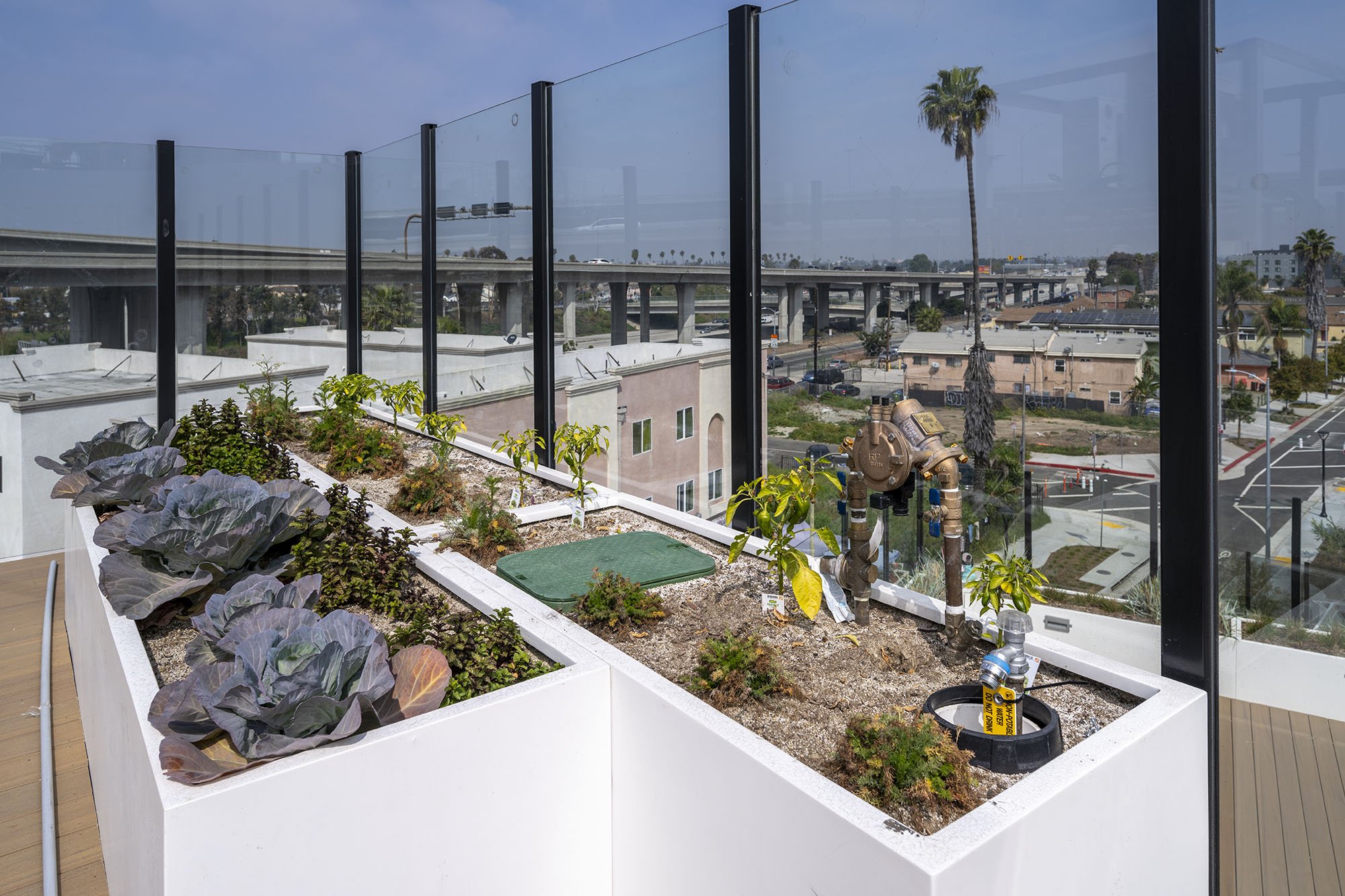
Tell us About the Paseo
Putting a stable roof over people’s heads was “the beginning of the effort, not the end of it,” declared Wallis Annenberg at the ribbon-cutting, adding that the entire development is “clean, green and livable.” Key to the holistic impact of Isla Intersections is the Paseo, sponsored by the Annenberg Foundation. The Annenberg Paseo is conceived as a “shared street,” meaning the public right of way has “a more equal balance between cars and public life,” explains the landscape architect Chris Torres. This involved turning a wide, straight road that cars could race down into a wavy, narrow one that slowed traffic. They added pavers that flowed into the courtyard of the housing, a water wall, widening sidewalks from four feet to 25, and adding a growing canopy of trees, irrigated by a gray water system.
Since the street is a public, making all these changes involved extensive and time-consuming permitting. “One of the biggest challenges in re-thinking our streets is that we have engineered a city based on automobility,” says Torres. “This thinking is pervasive from high level policy down to our public codes. Isla Intersections pushed a radically different agenda for Los Angeles and over two years of exhaustive permitting revisions broke the seal on how to build streets as places of civic joy.”
Torres chose Brisbane Box, Melaleucas and Camphor tree for their drought tolerant and pollution-absorbing properties. Birds are already coming back, says Torres, adding that the Paseo points a way forward. “Los Angeles has over 7,500 miles of streets,” he has said. “We hope this project can be a case study for a more resilient future for LA.”
For Wallis Annenberg, the goal is a wider impact, in which Isla Intersections stands as a prototype for further development of this kind. “It’s one thing to throw money at problems. If you can find the money to throw, it’s much better to create a whole new model for change, and one that can be copied and leveraged and achieve a far greater impact all around the world.”
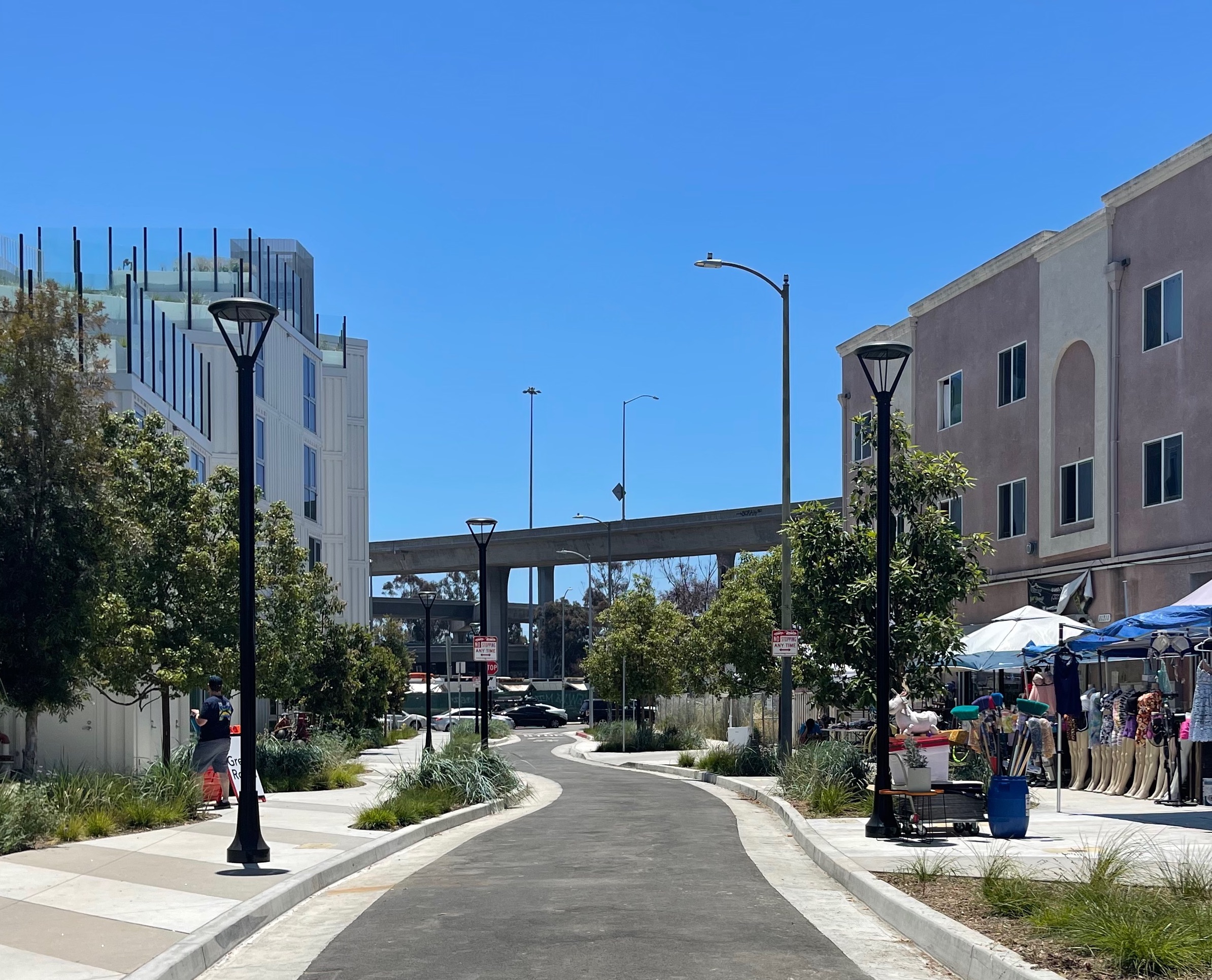
Why Shipping Containers?
Isla Intersections was conceived to be built fast and affordably using shipping containers made by a company called Giant. At the opening Mayor Karen Bass endorsed them, saying “I love the idea of containers. This is actually what the US does overseas. So (if) we can do things internationally, we can do things right here.”
A good number of housing builders are looking at prefabricated modules such as shipping containers, complete with kitchens, bathrooms and fittings and fixtures installed, as a faster, cheaper alternative to traditional on-site construction, though to date homebuilding in factories has been more widely embraced overseas.
At their most efficient, modular units are stacked in a ruthlessly repetitive, standardized arrangement and made locally, reducing the cost of delivery. At Isla Intersections, they were shipped from China and then customized. The 20-foot-long x 8-foot-wide recycled steel containers were welded together to form 480-square-foot units, laid on top of each other in stacks of two to five stories, and arranged into 16 staggered towers that are connected by a series of walkways to create a single unified building. This customization enabled the project’s creative design but added complexity and cost. You can watch them being installed in this video, by Gabor Ekecs.
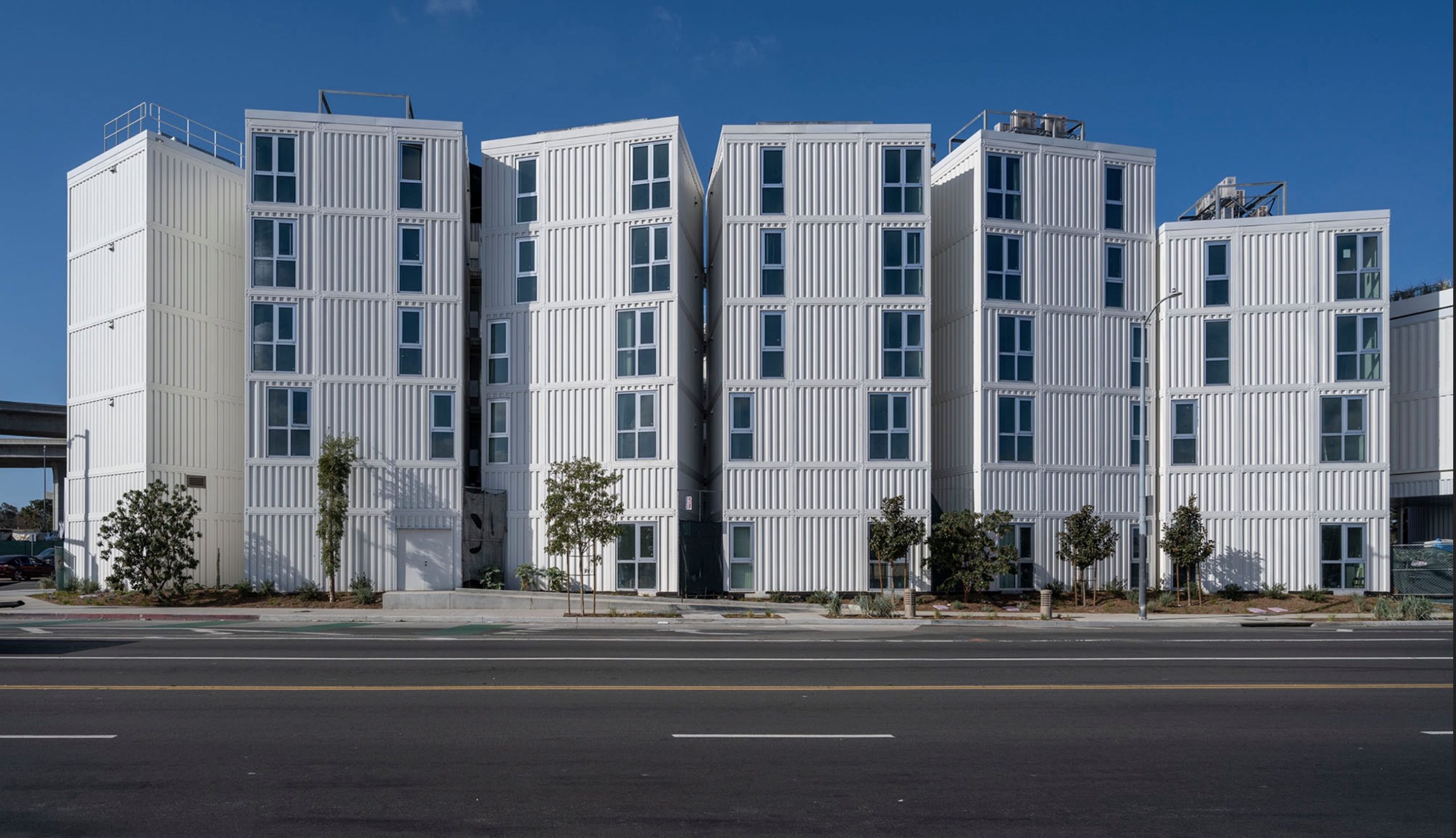
Obstacles and Costs
The project took seven years, and required perseverance and dedication from all involved. Expenses went up and up, meaning the one-bedroom units ended up costing almost $700,000 each. This was in part due to starting the project just when the pandemic hit, which caused shipping delays. But there were other challenges along the way, one of the main ones being the bundling of the loans. Isla Intersections got funding from a long list of generous funders. But each loan took time to apply for and receive, adding time and pushing up carrying costs.
Then there was bureaucracy. Even though Isla Intersections represents an admirable collaboration between the public and private sector, numerous aspects of the untested project involved lengthy permitting processes, which again added unnecessary extra time and expense.
These kinds of challenges beset many “affordable” housing projects, and as a result taxpayers see eye-watering construction costs and wonder if their HHH money is being efficiently used. If the funding were streamlined and centralized, and red tape was cut, say developers, visionary projects like Isla Intersections could be far less costly to build. One ace in the hand however, for Holos Communities, was the availability of the site, a piece of surplus land.
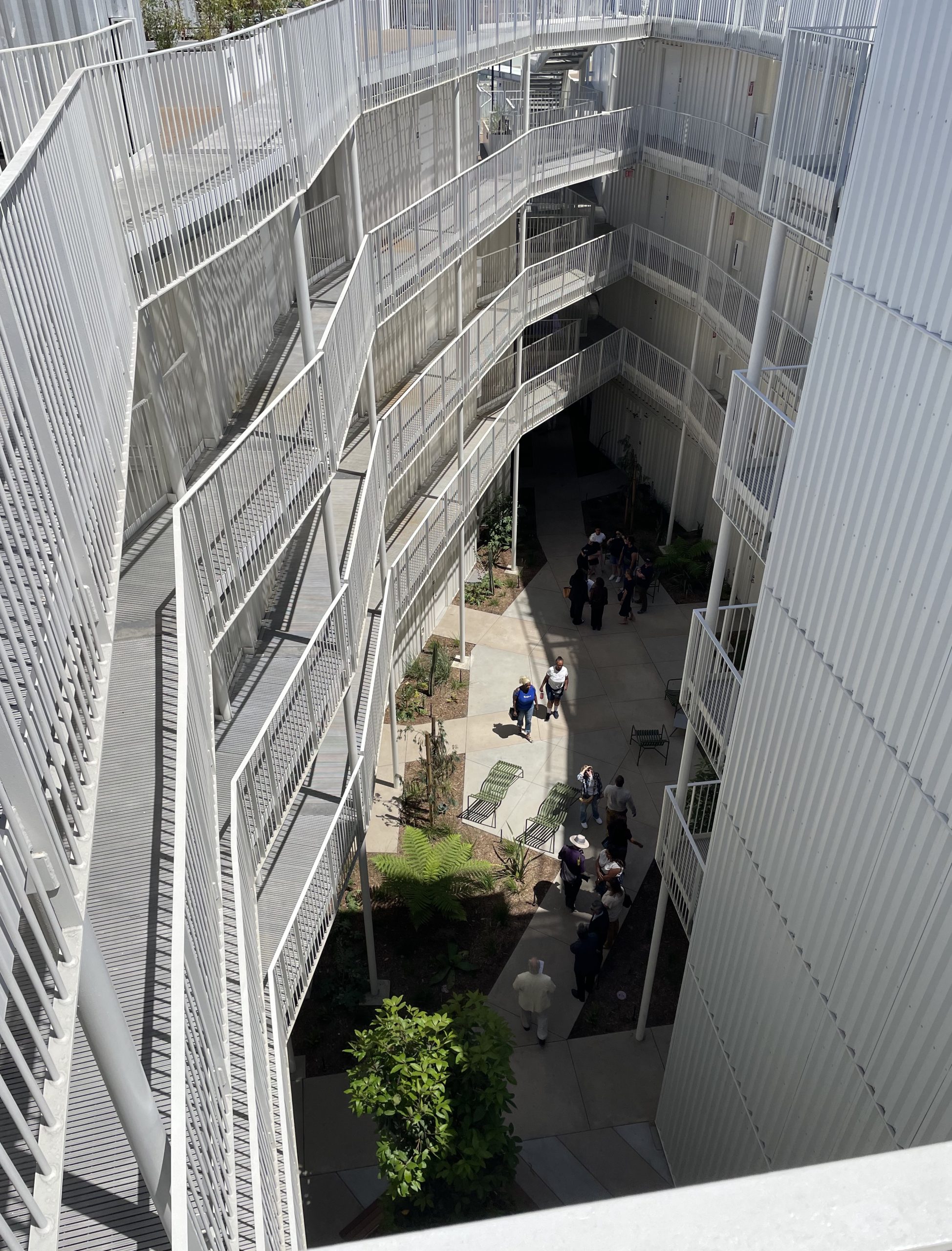
Surplus Land and ED3
Isla intersections is built on land given to the development team by the City of LA for $1/year for a 99-year lease. “In LA, there are few financing tools the city can offer,” Cristian Ahumada, Executive Director of Holos Communities told Fast Company. “So if you’re given land, that’s huge. That’s as good as money in the bank.”
In February 2023, Mayor Karen Bass signed Executive Directive 3 to accelerate the building of permanent and interim housing on publicly-owned sites deemed “surplus”. In many cases these parcels have been abandoned for years and are tricky to develop due to their shape or location, or they might comprise a combination of scattered smaller parcels.
ED 3 also required delivery of a comprehensive inventory of the more than 3,300 city-owned parcels to determine suitable sites as well as a new program to explore innovative ways to scale up affordable housing on publicly owned land, which include: grouping multiple sites by one developer; new financing and construction and innovative methods.
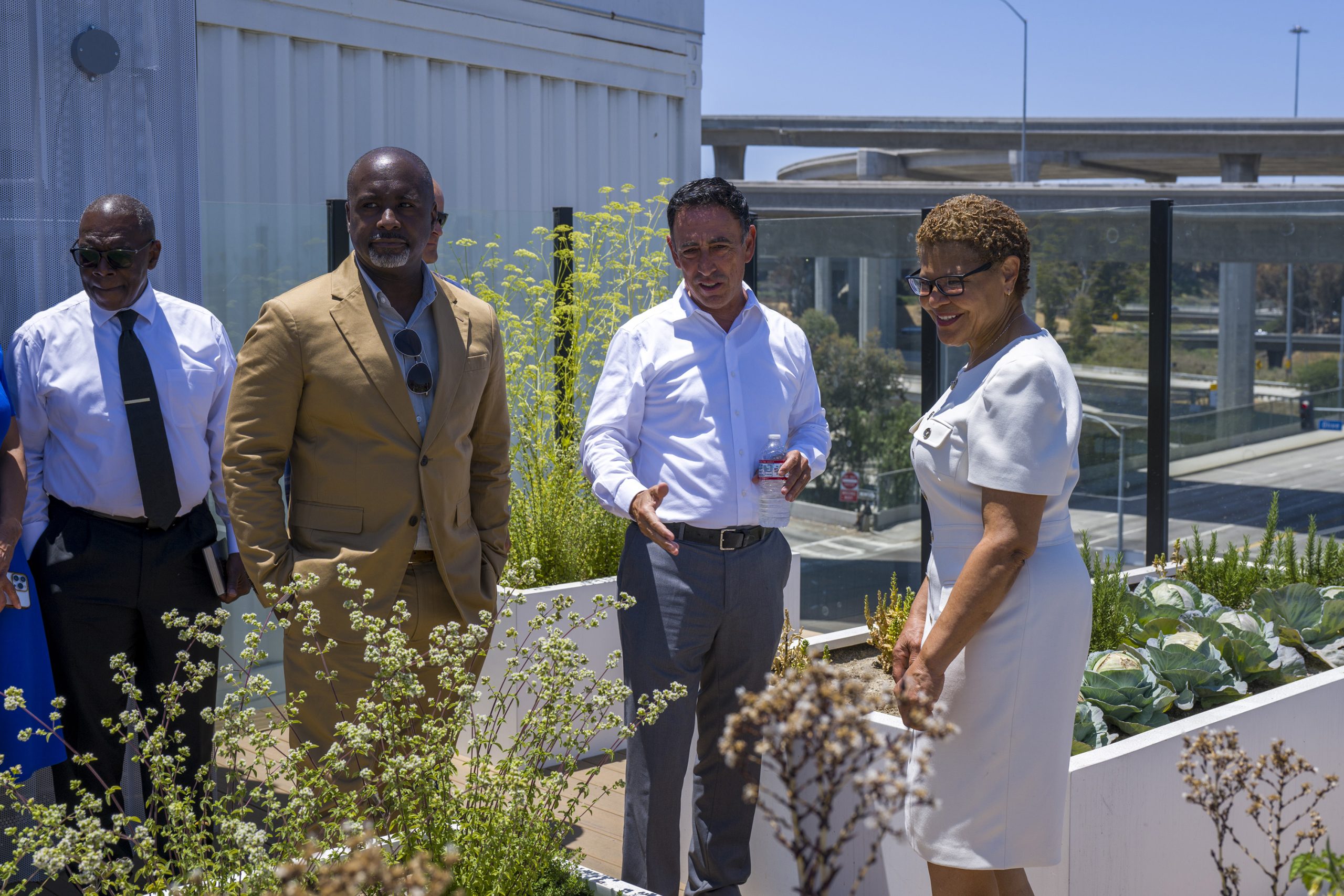
Bass also urged other jurisdictions that control real property in the City to adopt similar policies. These include Los Angeles County, LA Metro, Los Angeles Unified School District (LAUSD), the California Department of Transportation (CalTrans), and other departments or agencies of the State of California.
The City Council has also introduced a motion to remove zoning and density restrictions that would limit the amount of housing produced on City-owned parcels that is for civic purposes and publicly-owned affordable housing.
Per the City of Los Angeles Housing Element,in the development pipeline there are 7,891 units of housing on public land, which includes City sites, Housing Authority of City of LA and Metro Joint Development program. Moreover, the Housing Element plans for 10,000 new housing units on public land at different income levels. Additionally, MTA has identified 20 new sites for development to build 10,000 units of mixed-income and affordable housing.
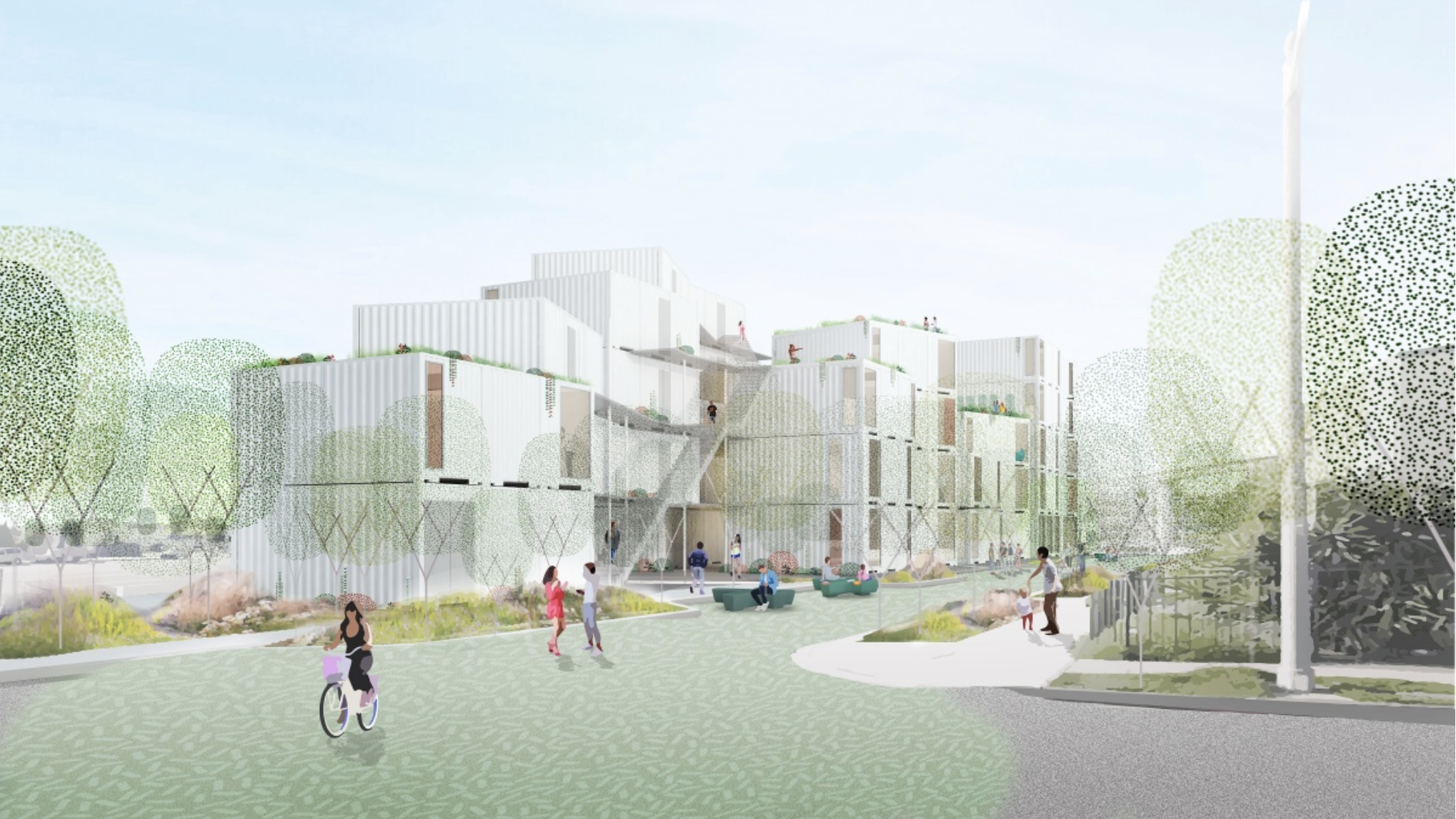
More on The Design Team
Isla Intersections owes its ambition to the combined efforts of Holos Communities, Lorcan O’Herlihy Architects (LOHA), and Chris Torres and the landscape architecture firm Agency Artifact. Each is known for pushing the envelope. Holos Communities (formerly Clifford Beers Housing) has developed several notable supportive housing projects with talented design teams, including 28th St. Apartments with Koning Eizenberg Architecture, and, with LOHA, King 1101 Apartments.
O’Herlihy is the noted architect of residential, cultural and commercial building in Los Angeles, Detroit and his native Ireland, but he made his mark in LA with his aesthetically and socially creative, market rate and affordable multifamily complexes, including for Formosa 1140 in West Hollywood, and, most recently, The Wilson in Santa Monica.
Chris Torres and his firm design inventive small gardens, but their main focus is on large landscape infrastructure projects and master planning and greening entire communities. Projects include including a 2000 acre Central Park for the San Fernando Valley and a concept for a “Festival Trail,” a 22-mile walk, bike and roll corridor that connects all the LA 28 Olympic Games venues and “lives on as a new way of moving through Los Angeles.” Stay tuned!
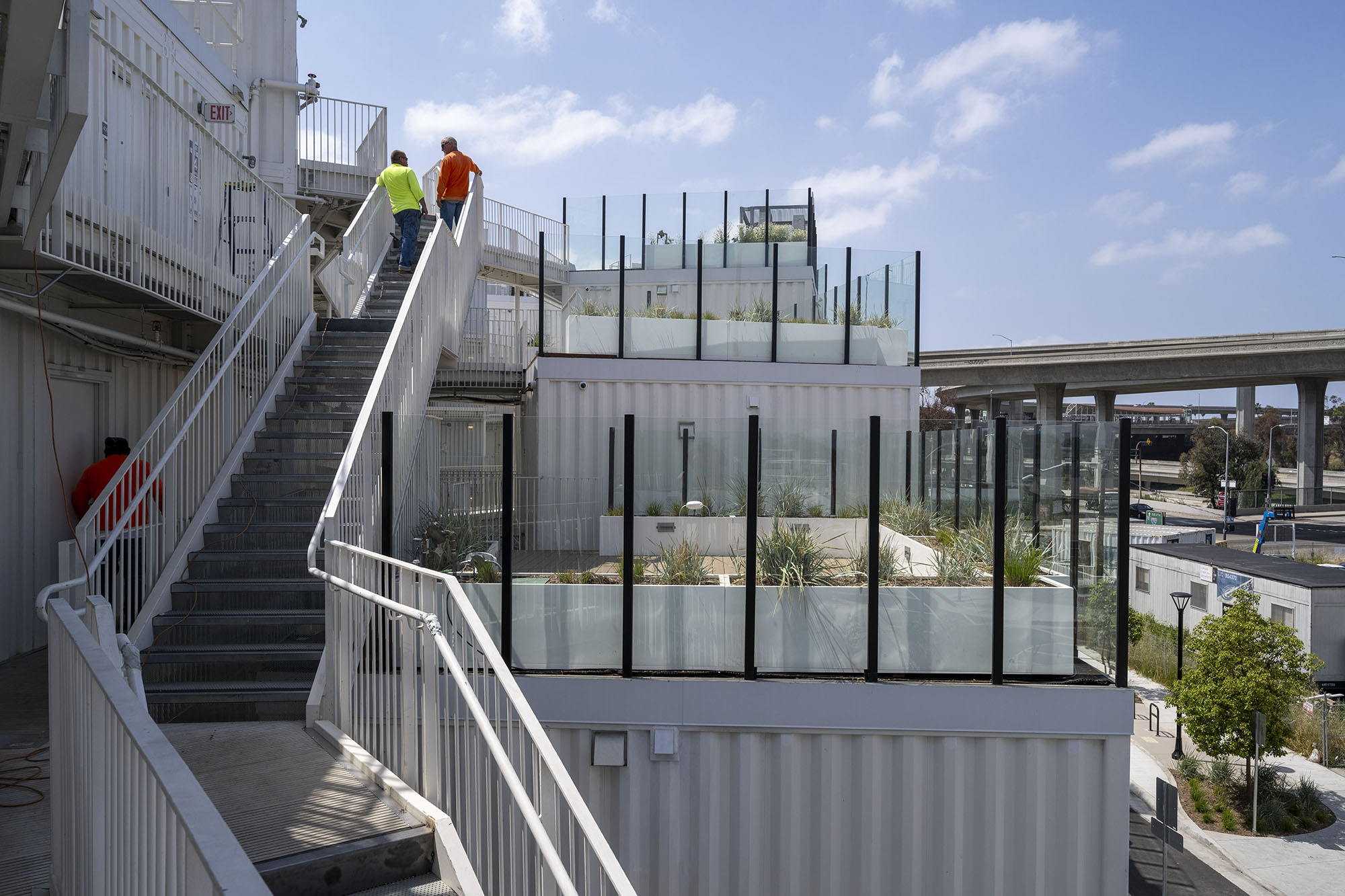
Call To Action
Visit the project and experience in person the “living lung.” Support similar projects in your neighborhood.
For more on development of surplus land, read Lorcan O’Herlihy’s article, here.